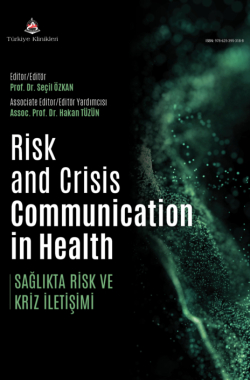Introduction to Risk and Crisis Communication
Özge TONBULOĞLU ALTINERa , Seçil ÖZKANa
aGazi University Faculty of Medicine, Department of Public Health, Ankara, Türkiye
Tonbuloğlu Altıner Ö, Özkan S. Introduction to risk and crisis communication. In: Özkan S, ed. Risk and Crisis Communication in Health. 1st ed. Ankara: Türkiye Klinikleri; 2024. p.1-6.
ABSTRACT
Risk and crisis communication is an area of research and practice that is rapidly developing and becoming increasingly important. Risk communication encompasses the communication activities carried out to prevent the risks that individuals or organisations may encounter in their lives from turning into a crisis. Risk communication is a fundamental element for crisis preparation and mitigation, because a crisis is usually a manifestation of a risk. Crisis communication is broadly defined as the collection, processing and sharing of information necessary to deal with a crisis situation. Each of the crisis phases has its own specific communication requirements. Although both communication areas share some common goals, they also have certain differences. While risk communication is based on continuous projections and calculations about the potential for future damage, crisis communication is considered as a spontaneous and reactive process that usually occurs in unexpected and acute situations. However, both forms of communication share the underlying aim of limiting, controlling and minimising potential harm.
Keywords: Risk; communication
Kaynak Göster
Referanslar
- Turancı E. Risk iletişimi açısından bilginin önemi ve bilgi okuryazarlığı. İletişim Kuram ve Araştırma Dergisi. 2018;2022(47):191-208.
- Sellnow TL, Seeger MW. Theorizing crisis communication. 2nd ed. USA: John Wiley & Sons; 2021.
- Gülgün BS. Halk sağlığı krizlerinde kriz iletişimi ve kriz haberciliği: Örnek olay A/H1N1 (Domuz Gribi) Pandemisi [Yüksek Lisans Tezi]. Ankara: Ankara Üniversitesi Sosyal Bilimler Enstitüsü; 2011.
- Liu BF, Viens J. Crisis and risk communication scholarship of the future: Reflections on research gaps. Journal of International Crisis and Risk Communication Research. 2020;3(1):7-13. [Crossref]
- Brunner BR. Public relations theory: Application and understanding. USA: John Wiley & Sons; 2019.
- Lundgren RE. Risk communication: A handbook for communicating environmental, safety and health risks. Columbus, OH: Battelle Press; 1994.
- Reynolds B, Seeger MW. Crisis and Emergency Risk Communication as an Integrative Model, Journal of Health Communication. 2005;10(1):43-55. [Crossref] [PubMed]
- Online Etymology Dictionary. Communication. [cited: March 12, 2024]. Available from: [Link]
- Khan S, Mishra J, Ahmed N, Onyige CD, Lin KE, Siew R, et al. Risk communication and community engagement during COVID-19. International Journal of Disaster Risk Reduction. 2022;74:102903. [Crossref] [PubMed] [PMC]
- Manuele FA. On the practice of safety. 3rd ed. New York: Wiley-Interscience; 2003. [Crossref]
- Covello VT. Risk communication: An emerging area of health communication research. Annals of the International Communication Association. 1992;15(1): 359-73. [Crossref]
- Ağca ME. Afet Odaklı Risk İletişiminde Sosyal Medya Kullanımı: AFAD Örneği. Uluslararası Medya ve İletişim Araştırmaları Hakemli Dergisi. 2023; 6(1):41-60. [Crossref]
- Kırdar Y, Demir FO. Kriz İletişimi Aracı Olarak İnternet: Kuş Gribi Krizi Örneği. İstanbul Üniversitesi İletişim Fakültesi Dergisi. 2011;29:93-106.
- Seeger MW, Sellnow TL, Ulmer RR. Communication and organizational crisis. Westport, CT: Greenwood Publishing Group. 2003. [Crossref]
- Can H. Organizasyon ve Yönetim. 1. Baskı. Ankara: Siyasal Kitabevi; 2002.
- Coombs WT. Crisis management and communications. Institute for public relations. 2007; 4(5), 6.
- Coombs WT. Ongoing Crisis Communication: Planning, Managing, and Responding . Thousand Oaks, CA: Sage; 1999.
- Seeger MW, Sellnow TL, Ulmer RR. Communication, organization and crisis. In: Roloff ME, ed. Communication Yearbook 21. Thousand Oaks, CA: Sage; 1998. p. 230-75. [Crossref]
- Fearn-Banks K. Crisis Communication. New Jersey: Lawrence Erlbaum Association; 2002.
- Sellnow TL, Ulmer RR, Seeger MW, Littlefield RS. Introducing a message-centered approach to risk communication. Effective Risk Communication: A Message-Centered Approach. 2009;3-18. [Crossref]
- Infanti J, Sixsmith J, Barry MM, Núñez-Córdoba J, Oroviogoicoechea-Ortega C, Guillén-Grima F. A literature review on effective risk communication for the prevention and control of communicable diseases in Europe. Stockholm: ECDC; 2013. [Crossref] [PubMed]
- Palenchar MJ. Historical trends of risk and crisis communication. In: Heath RL, O'Hair HD, eds. Handbook of risk and crisis communication. Routledge; 2020. p. 31-52. [Crossref]
- Centers for Disease Control and Prevention. Crisis&Emergency Risk Communication [cited: March 15, 2024]. Available from: [Link]
- Centers for Disease Control and Prevention. Crisis Emergency Risk Communication: Introduction 2018 [cited: March 12, 2024]. Available from: [Link]
- Tüzün H, Demirköse H, Özkan S, Dikmen AU, İlhan MN. COVID-19 Pandemisi ve Risk İletişimi. Gazi Sağlık Bilimleri Dergisi. 2020;1-8.
- World Health Organization. An introduction to risk communication [cited: March 12, 2024]. Available from: [Link]
- Sellnow TL, Ulmer RR, Seeger MW, Littlefield R. Effective risk communication: A message-centered approach. Springer Science & Business Media, 2008. [Crossref]
- Lundgren RE, McMakin AH. Principles of risk communication. 2013. [Crossref]
- Dhami MK. Towards an evidence-based approach to communicating uncertainty in ıntelligence analysis. Intell. Natl. Secur. 2018;33:257-72. [Crossref]
- Vural AM, Taşkıran HB, Türkoğlu S, Sarı M, Maral T, Keskin RK, et al. İnternet gazetelerinde depremin haberleştirilmesi: Türkiye'nin en çok ziyaret edilen haber sitelerinde deprem içerikli haberlerin risk iletişimi bağlamında analizi. Yeni Medya. 2022;13:25-54. [Crossref]
- T. C. Tarım ve Orman Bakanlığı. Risk İletişimi. [Erişim Tarihi: 15.03.2024]. Erişim Linki: [Link]
- Özgür ÖF. Kriz Yönetimi ve Kriz İletişimi Bağlamında Soma Maden Faciası Krizine Bakış. Injosos Al-Farabi International Journal on Social Sciences. 2018;2(2):29-55.
- Peltekoğlu FB. Halkla İlişkiler Nedir? İstanbul: Beta Basım; 2012.
- Alay D, Eke E. Sağlık Bakanlığı'nın Kriz İletişimi Üzerine Bir Araştırma. Süleyman Demirel Üniversitesi Sosyal Bilimler Enstitüsü Dergisi. 2023;2(46): 317-37.
- Centers for Disease Control and Prevention. CERC: Crisis Communication Plans 2014. [cited: March 12, 2024]. Available from: [Link]
- Seeger MW. Best practices in crisis communication: An expert panel process. Journal of applied communication research. 2006;34(3):232-44. [Crossref]
- Bakker MH, Kerstholt JH, Giebels E. Deciding to help: Effects of risk and crisis communication. Journal of contingencies and crisis management. 2018; 26(1):113-26. [Crossref]
- Reynolds B, Galdo JH, Sokler L, Freimuth VS. Crisis and emergency risk communication. [cited: March 12, 2024]. Available from: [Link]

